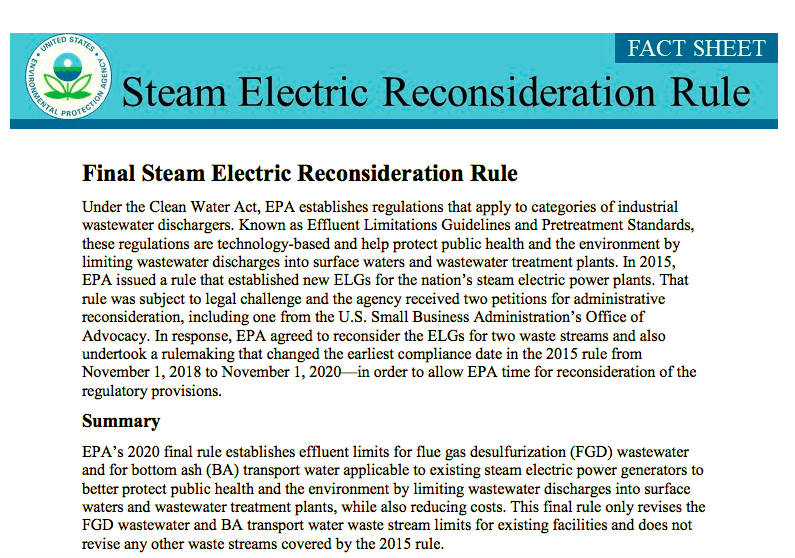The U.S. Environmental Protection Agency (EPA) has finalized a rule that revises regulations for coal-fired power plants, a move that will limit the number of generation facilities that could incur costs for failing to comply with pollution limits. The action on Aug. 31 revises a rule established in 2015, when the EPA issued an order that for the first time set federal limits on the levels of toxic metals in wastewater that could be discharged from power plants.
The EPA on Monday said its revision “to the technology-based effluent limitations guidelines and standards (ELGs) for the steam electric power generating point source category” is applicable to flue gas desulfurization (FGD) wastewater and bottom ash (BA) transport water. The agency said the final Effluent Limitations Guidelines rule, which will become official when it is published in the Federal Register, “is estimated to save approximately $140 million annually in after tax compliance costs” because it allows for the use of “less costly FGD wastewater technologies that could be used with the modification of the Steam Electric Power Generating Effluent Guidelines 2015 rule (the 2015 rule) limitations.”
The revised rule had been eagerly awaited by the coal industry as plant operators struggled with uncertainty about how to comply with the 2015 rule, which was the first update to power plant effluent standards since 1982. Court rulings subsequent to the 2015 rule had actually called for stronger limits on pollution, but the Trump administration in early 2017 signaled its intention to revise the Obama-era guidelines.
A major feature of the revised rule is the elimination of the zero-discharge requirement for bottom ash transport water. The 2015 rule required all wastewater to be recirculated, something coal plant operators argued would increase their operating costs.
Coal industry executives, critical of the original restrictions which they characterized as costly and burdensome, praised Monday’s changes. Andrew Wheeler, the EPA administrator who is a former coal industry lobbyist, described the revisions as “more affordable pollution control technologies” that would “reduce pollution and save jobs at the same time.”
The new rule allows for the use of “less costly BA transport water technologies,” and grants “a two-year extension of compliance time frames for meeting FGD wastewater and BA transport water limitations, [along] with additional subcategories for both FGD wastewater and BA transport water.” The EPA added that, “Participation in the voluntary incentive program would contribute to the reduction in pollutant discharges by these steam electric power plants in FGD wastewater by approximately 26.7 million pounds per year.”

The rule announced Monday is similar to one proposed last year, but it extends the timeline for plants to comply. The rule gives power plants until year-end 2025 to comply with the revised regulations. The EPA also has established a voluntary incentive program whereby power plants would have until 2028 to comply if they decide to include more biological treatment. Coal plants that will close, repower, or switch to natural gas by 2028 are exempt.
Michelle Bloodworth, president and chief executive of industry group the American Coalition for Clean Coal Electricity, said in a statement that the Obama-era standards “could have forced the closure of additional coal-fueled power plants that are necessary to maintain the reliability and resilience of the nation’s electricity supply.”
More coal-fired power generation has been retired during the first three-and-a-half years of President Trump’s administration than during the final four years of the Obama presidency. About 48 GW of coal-fired generation retired during President Obama’s eight years in office, and about 33 GW of that came in his second term, according to an analysis of U.S. Energy Information Administration data. About 37 GW of coal-fired capacity has been retired since Trump took office, a figure expected to rise above 40 GW by the end of 2020 based on announced retirements. U.S. electricity output from coal fell to a 42-year low in 2019, and about 4,500 jobs in the coal industry were lost in just the first six months of 2020, according to government employment data.
2015 Rule Faced Legal Challenges
The 2015 rule established during the Obama administration was subject to legal challenges, and the EPA received two petitions for administrative reconsideration, including one from the Office of Advocacy for the U.S. Small Business Administration. The Trump administration’s EPA in response to those petitions agreed to reconsider the ELGs for two waste streams, and Monday’s 2020 rule contains the final revisions for those guidelines.
Environmental groups on Monday immediately decried the EPA’s revisions. Frank Holleman, senior attorney at the Southern Environmental Law Center, in an email to POWER said, “With today’s rollback of clean water protections, the Trump EPA allows dirty coal-burning plants to dump more toxic substances into our rivers, lakes, and drinking reservoirs and exposes our communities to more cancer-causing pollution. The EPA itself has estimated that at least 30 percent of all toxic water pollution from all industries comes from these plants, and the technology to prevent and treat this pollution is widely available. The EPA is making it easier for the most polluting and worst run coal-fired plants to dump poisons into the waterways our communities depend upon.”
The EPA in 2015 when it announced the initial rule, which required the use of modern technologies to treat wastewater, estimated that improvements at coal-fired plants would have prevented 1.4 billion pounds of pollutants from entering U.S. waters annually. The EPA at that time said the 2015 rule would provide $451 million to $566 million per year in public health and environmental benefits.
According to the EPA, the 2020 final rule released Monday effectively:
- Changes the technology-basis for treatment of FGD wastewater and BA transport water.
- Revises the voluntary incentives program for FGD wastewater.
- Adds subcategories for high-flow units, low utilization units and those that will transition away from coal combustion by 2028 and finalizing requirements that are tailored to facilities in these subcategories.
- Establishes new compliance dates.
The EPA on Monday said it estimates that the final 2020 rule will save coal-fired power plant operators “$127 million per year in social costs and result in between $[minus]1.7 million and $43 million in benefits.”
Thom Cmar, deputy managing attorney of the Earthjustice Coal Program, in an email to POWER said, “The Trump administration is once again jeopardizing people’s health to give coal power industry lobbyists what they want. This dangerous decision will have a big impact because dirty coal-fired power plants are by far the number one source of toxic chemicals in our water. The Trump administration’s rollback will be responsible for hundreds of thousands of pounds of pollutants contaminating sources of drinking water, lakes, rivers and streams every year. We will challenge this rule change in court.”
The 2020 rule says only those coal-fired power plants that discharge bottom ash transport water or FGD wastewater may now incur compliance costs. The EPA said it estimates that 75 plants may incur compliance costs under the final rule, out of a total of 914 plants that could be covered by the rule.
The EPA said the earliest a plant will need to comply with the new rule is one year from the rule’s publication in the Federal Register, or 2025 for best available technology. The agency said Monday’s revisions will apply to wastewater generated at coal-fired power plants when sulfur dioxide is removed from the facilities’ emissions, as well as water used to flush the bottom ash out of plants and into coal ash pits.
Change to Treatment Process
The new rule, citing lower compliance costs, allows power plants to use a shorter biological treatment process for wastewater, which will increase allowable levels of selenium. The revised rule sets a daily maximum limit on selenium at 76 micrograms per liter, more than three times the Obama-era limit of 23 micrograms per liter. The monthly average treatment in the new rule is 31 micrograms per liter, compared with 12 micrograms per liter in the Obama-era rule.
The revised rule exempts some plants from the biological treatment process, which environmentalists and industry analysts say will allow those plants to significantly increase their discharge levels of arsenic, mercury, and nitrogen. Those exempt plants include those with high flows of wastewater, along with coal-fired plants that are used only during periods of peak power demand. The EPA said those plants are allowed to release about 10 times as much mercury — 788 micrograms per liter each day — as plants that are required to treat wastewater. Those plants are limited to 85 micrograms of mercury per liter daily.
The Obama-era rule required all power plants to dispose of bottom ash, the residue left after coal is burned, while continuously recycling the process water. That eliminated the discharge of that water, which can be very toxic. The new rule allows 10% of the process water to be discharged each day, and the EPA said the revised rule allows states to make case-by-case decisions on those discharges.
—Darrell Proctor is associate editor for POWER (@DarrellProctor1, @POWERmagazine).










